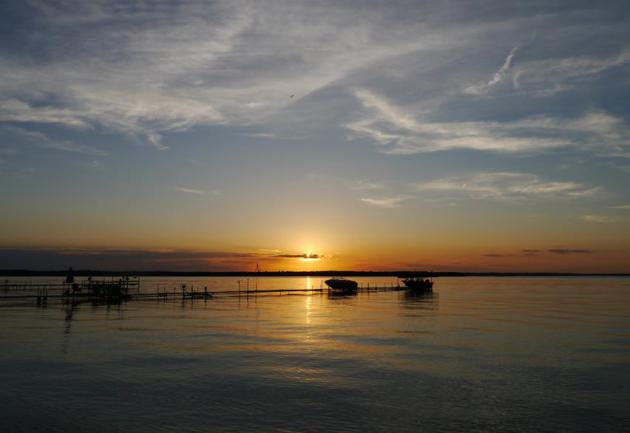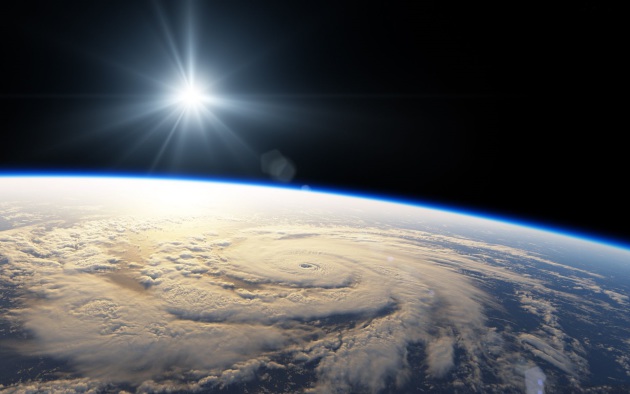.37" rain fell at MSP International Airport as of 7 pm yesterday.
71 F. high temperature yesterday in the Twin Cities.
82 F. average high on August 9.
87 F. high on August 9, 2016.
August 10, 1939: Very heavy rain falls at Two Harbors, accumulating to 5.2 inches of rain.
The One Weather Risk We Don't Have to Worry About
Everyone, everywhere likes to brag about their local weather. I tend to hear from a handful of Florida friends in January. They send me helpful weather reports - and photos of lukewarm sunsets on the beach. Very nice. It gets quiet this time of year, at the onset of hurricane season, when storms (with names) menace.
"Franklin" was the 6th named storm of 2017; that's twice as many storms as normal as of early August. And the latest outlook from NOAA? "The season has the potential to be extremely active, and could be the most active since 2010." Call me crazy but Texas-size storms packing 20-foot waves put our scrawny thunderstorms into stark perspective.
Showers linger today, but the sun becomes visible Friday - and much of the upcoming weekend with comfortable 70s and low humidity. A few weekend T-showers may brush southwest Minnesota and the Arrowhead, but most of us will salvage a nice weekend - probably better for outdoor plans than last weekend.
A rerun of 80s and a few 90s is likely by late August for the fair. I'll be hanging out at the deodorant-on-a-stick booth.
* Hurricane Dennis file image: NASA.
Hurricane Season, Already Busy, May Get Even Busier. The New York Times has more perspective.

Remarkable Resolution.
The new GOES-16 imagery is pretty incredible - I'm seeing things
(details on overshooting tops on thunderhead anvils) I've never seen
before. The visible imagery is even more impressive close to sunset,
when the western edge of showers and T-storms are lit up, highlighting
details in the cloud formation. GOES-16 is still non-operational, this
is test data. Imagery: NOAA and AerisWeather.
Near Real-Time Lightning. Check out the Blitzortung.org site,
which uses triangulation of personal lightning detectors to display
lightning strikes. Be sure to turn up the volume to get the complete
effect!
Thursday Flash Flood Risk.
NOAA predicts an elevated threat of torrential rains, capable of flash
flooding, from eastern Colorado and southern Kansas into northern
Oklahoma today.

Little Has Changed Since June.
The west is dry, while gangs of heavy thunderstorms continue to bubble
up east of the Rockies. Light showers linger from Minnesota and
Wisconsin into the U.P. of Michigan with heavier T-storms over the
southeastern USA. Strong strong storms flare up over the central USA
tomorrow and spread to the east coast by Saturday afternoon. 84-hour NAM
guidance: NOAA and Tropicaltidbits.com.
Seriously Wet.
Check out some of these QPF rainfall predictions; upwards of 8" of rain
near Tulsa by next Thursday? Heaviest rains stretch from Texarkana into
the Deep South, Carolinas and Mid-Atlantic region.
Gradual Warming Trend.
Soak up 70s for highs, because next week will feel a little more like
the Dog Days of August. Not excessively hot, but humidity levels will be
rising, and highs in the 80s will make it easier to take a dip in your
favorite lake. Twin Cities ECMWF forecast: WeatherBell.
Photo credit: "A small boat transports flood victims down Old Hammond Highway in east Baton Rouge on Aug. 14, 2016." Credit: Travis Spradling/The Advocate.
Image credit: "The Sentinel-2 satellite captured a wildfire burning in western Greenland." Credit: Pierre Markuse/flickr.
Gambling with Mother Nature. People living on or near the coast are already gambling, and the risks are only increasing as water levels continue to rise. Here's an excerpt from The Miami Herald: "For Floridians with no debt on their homes by or near the water, dropping the flood or other insurance previously required by their mortgage lenders could become a greater and greater gamble over time — especially if they live in areas affected by rising tides and sea level. Sunshine State homeowners who must insure their properties are buying policies from an industry that already is reacting to what it sees as global climate change — and its accompanying potential for more frequent flooding and storms and escalating damage claims. That reaction is one of caution that ultimately could call for dramatically increasing premiums — or even declaring some areas too risky to underwrite at any cost. While politicians still debate whether climate change or the impact — rising sea levels — are real, insurers already are preparing, especially in states like Florida. Besides the cost, the results could impact where people can live..."
Senate Restores Funding for NASA Earth Science and Satellite Servicing Programs. Some good news to report, courtesy of Space.com: "An appropriations bill approved by a Senate committee July 27 would restore funding for several NASA Earth science missions slated for termination by the administration as well as a satellite servicing program. The Senate Appropriations Committee approved a commerce, justice and science (CJS) appropriations bill, along with two other spending bills, during a markup session. The CJS bill, offering $19.529 billion for NASA overall, had cleared its subcommittee July 25..."
Image credit: "NASA's Restore-L mission would develop satellite servicing technology and refuel the Landsat 7 spacecraft." Credit: NASA.
Fossil Fuel Subsidies are a Staggering $5 Trillion Per Year. A new study finds 6.5% of global GDP goes to subsidizing dirty fossil fuels. University of St. Thomas climate scientist John Abraham reports for The Guardian: "...A study was just published in the journal World Development that quantifies the amount of subsidies directed toward fossil fuels globally, and the results are shocking. The authors work at the IMF and are well-skilled to quantify the subsidies discussed in the paper. Let’s give the final numbers and then back up to dig into the details. The subsidies were $4.9 tn in 2013 and they rose to $5.3 tn just two years later. According to the authors, these subsidies are important because first, they promote fossil fuel use which damages the environment. Second, these are fiscally costly. Third, the subsidies discourage investments in energy efficiency and renewable energy that compete with the subsidized fossil fuels. Finally, subsidies are very inefficient means to support low-income households..."
Beijing file photo: Aaron Farr, Flickr.
Even With All Our Gadgets, Americans Are Using Less Electricity Than 10 Years Ago. Here's an excerpt from Recode: "Everything
from our heating systems to our toothbrushes is plugged in and
connected to the internet, and smartphones are glued to the palms of our
hands. Yet, Americans are using less electricity than we did 10 years
ago. Overall residential electricity sales have declined 3 percent from
2010 to 2016, and 7 percent on a per capita basis, according to data
from the U.S. Energy Information Administration. Our numerous gadgets are all getting more efficient, so they’re less of a drain on residential electric bills..."
Energy Department Reports: Wind Energy Continues Rapid Growth in 2016. Texas, Oklahoma and Iowa lead the nation. Here's an excerpt from The Department of Energy: "The Energy Department today released three wind market reports demonstrating continued growth in wind energy nationwide. America’s wind industry added more than 8,200 megawatts (MW) of capacity last year, representing 27 percent of all energy capacity additions in 2016. In 2016, wind supplied about 6 percent of U.S. electricity, and 14 states now get more than 10 percent of their electricity from wind. The reports cover the following market sectors: land-based utility scale, offshore, and distributed wind...In the past year, Iowa and South Dakota produced more than 30 percent of their electricity from wind, and 12 other states exceeded 10 percent (Kansas, Oklahoma, North Dakota, Minnesota, Colorado, Vermont, Idaho, Maine, Texas, Oregon, New Mexico, Nebraska)..."
This Type of Videogame May Actually Harm Your Brain. Fortune reports: "Video game effects on the brain have been heavily debated for decades, with a chief concern being that action video games like Call of Duty
influence aggressive and violent behavior. Some experts believe these
adverse effects have been overstated, but a new study from the
Université de Montréal has found habitually playing them may actually
harm your brain. Researchers had about 100 people play shooter games
like Call of Duty, Killzone, and Borderlands 2,
along with 3D Super Mario games for 90 hours. They found that
participants who favor their brain's caudate nucleus — an area
associated with the brain's reward system and habit formation — had less grey brain matter in their hippocampus after playing action games..."

People in Rich Countries are Dying of Loneliness. A story at Quartz made me do a double-take: "Sociologists
have long been warning about the dangers of increased isolation thanks
to aging populations, scattered families, and cultures that promote the
individual over the collective. Now, new research analyzing previous
studies suggests people who fall into the loneliness trap are 50% more
likely to suffer an early death than those who remain socially
connected. Previous studies have found that as many as a third of Americans
are lonely....Such “epidemics,” while not confined to rich countries,
are linked to prominent features of affluent culture: longer life
expectancy, decreasing marriage rates, people having fewer children, more people getting divorced, and more people living alone..."

How America Lost Its Mind. Kurt Andersen reports at The Atlantic: "...Each
of us is on a spectrum somewhere between the poles of rational and
irrational. We all have hunches we can’t prove and superstitions that
make no sense. Some of my best friends are very religious, and others
believe in dubious conspiracy theories. What’s problematic is going
overboard—letting the subjective entirely override the objective;
thinking and acting as if opinions and feelings are just as true as
facts. The American experiment, the original embodiment of the great
Enlightenment idea of intellectual freedom, whereby every individual is
welcome to believe anything she wishes, has metastasized out of control.
From the start, our ultra-individualism was attached to epic dreams,
sometimes epic fantasies—every American one of God’s chosen people
building a custom-made utopia, all of us free to reinvent ourselves by
imagination and will. In America nowadays, those more exciting parts of
the Enlightenment idea have swamped the sober, rational, empirical parts..."
Image credit: R. Kikuo Johnson.
The Eclipse of 1878 Almost Killed the Father of the National Weather Service. Expect similar madness on August 21. Atlas Obscura explains what can go wrong; here's a clip: "...Over
the next week or so, Abbe and his colleagues were battered with wind,
cold, and extreme weather as they tried to observe the skies in
preparation for the eclipse. But that wasn’t the worst of it. “They were
battling snowstorms in July that threatened to rust out their
telescopes. They also suffered significant altitude sickness,” says
Baron. Due to the extreme difference in air pressure and lack of oxygen
at such a high altitude, the astronomers experienced headaches,
dizziness, and disorientation. Many people can adjust to altitude
sickness, but that was not the case for Cleveland Abbe. The day before
the eclipse, Abbe woke to pain so extreme he could not stand. The
Langleys tried to convince Abbe to go down the mountain, but he refused,
holing up in his tent, insisting that he could recover. Later that
evening, General Myers finally made his way to the peak, where he
ordered Abbe taken off the peak on a stretcher..."
File image credit: "The eclipse of 1878 as observed from Wyoming." Étienne Léopold Trouvelot/Public Domain
Weather Presenter Loses It When a Giant Seagull Drops By. Check out the video, courtesy of The Dodo: "Tara Jean Stevens, co-host of the Canadian morning show Vancouver's Breakfast Television,
is responsible for delivering the forecast each day, but she certainly
didn't see this one coming. While presenting the weather on Tuesday,
Stevens was suddenly forced to share the airwaves with a scene-stealing
seagull. The bird, it seems, had decided to rest his wings directly in
front of the station's live skyline camera, making him look gargantuan.
It was almost like he knew exactly what he was doing. "I won't let him
distract me, though," Stevens said. Turns out, that was a promise she
couldn't keep..."
Can You Find the Typo? Hey, are the proofreaders on strike or what? Thanks to the New York Times' Brian Stelter for passing this along. Oops.
TODAY: Showers likely. Cool and gray. Winds: NW 7-12. High: 73
THURSDAY NIGHT: Showers taper with partial clearing. Low: 58
FRIDAY: Partly sunny and pleasant. Winds: N 7-12. High: 77
SATURDAY: Mix of clouds and sunshine. Winds: N 5-10. Wake-up: 59. High: 76
SUNDAY: Intervals of sun, isolated T-shower. Winds: NE 5-10. Wake-up: 60. High: 77
MONDAY: Plenty of sun, quite pleasant. Winds: NE 3-8. Wake-up: 61. High: 77
TUESDAY: Patchy clouds, stray T-storm possible. Winds: SE 8-13. Wake-up: 62. High: 78
WEDNESDAY: Humid again, more numerous storms. Winds: SE 10-15. Wake-up: 63. High: near 80
Climate Stories...

Photo credit: David Goldman/AP.

Illustration credit: Jim Cooke/GMG.
Government Report Finds Drastic Impact of Climate Change on U.S. It turns out it wasn't leaked after all - it's been in the public domain for some time now. Here's an excerpt from The New York Times: "The average temperature in the United States has risen rapidly and drastically since 1980, and recent decades have been the warmest in the past 1,500 years, according to a sweeping federal climate change report awaiting approval by the Trump administration. The draft report by scientists from 13 federal agencies, which has not yet been made public, concludes that Americans are feeling the effects of climate change right now. It directly contradicts claims by President Trump and members of his cabinet who say that the human contribution to climate change is uncertain, and that the ability to predict the effects is limited..."
File photo: NOAA.
Climate Leaks. VICE News has a few findings from the most recent climate change report compiled by 13 different agencies. Here are a few highlights:
- "Extreme weather events are occurring more frequently and have become more intense. The warmest days have become warmer since the early 1960s and extreme heat waves have become more frequent.
- Overall, it has rained more heavily and more frequently in the U.S. since 1901, and the highest increase has been observed in the northeastern part of the U.S.
- Oceans have risen 8-9 inches since 1880, the report found with “very high confidence,” citing human activity as making a “substantial contribution” to that rise..."
USDA Staff Were Coached Not to Say "Climate Change", E-mails Show. InsideClimate News has the story: "Four days after President Donald Trump took the oath of office, an official at the Department of Agriculture sent an email, the first in a string of messages signaling to staff that the term "climate change" could soon be erased from the agency's vocabulary. "It has become clear one of the previous administration's priorities is not consistent with that of the incoming administration," wrote Jimmy Bramblett, a deputy chief in the agency's Natural Resources Conservation Service (NRCS). "Namely, that priority is climate change. Please visit with your staff and make them aware of this shift in perspective within the Executive Branch." Over the course of the next six months, Bramblett and other officials sent emails to staff, coaching them to avoid using the term "climate change" and instead use the term "weather extremes..."
Photo credit: "An aircraft tries to seed clouds in Thailand in 2007. Any global dimming effort would require larger aircraft, flying higher in the atmosphere." Sukree Sukplang / Reuters.
No comments:
Post a Comment